Juno at Perijove-3: Close-up views of southern hemisphere
Southern hemisphere
Here are enhanced and annotated versions of the Perijove-3 images of the southern hemisphere. The general remarks and map in the previous 2 posts also apply here. Some of the images were processed by Gerald Eichstädt, and I have processed them further to enhance detail.
The positions of the permanent prograde jets are marked approximately, by reference to the cloud textures, as determined by previous spacecraft; but the highest-latitude jets are not well determined and could be irregular.
Figure 6 (Images 113, 114, 116) shows the close-up views from the SEB to the SSTB, and Figure 7 shows better-processed details from them, showing the beautiful cloud textures.
The SEB is the sector west of the GRS with its ongoing large-scale convective ‘rifts’.
The S. Tropical Zone and STBn jet and whitened STB are all essentially white but show contrasting cloud textures (which look three-dimensional when near the horizon, although it remains to be determined whether this is real).
In the S. Temperate Zone, the images show one of the dark spots that have been emitted westward from the dark patch beside oval BA (its shape suggests it is weakly anticyclonic), and a rimless white oval (which has beautiful anticyclonic spiral structure).
The SSTB in this sector (between ovals A3 and A4) is split into north and south components separated by a pale sector, shown more completely in the next image (117). Pale sectors like this are thought to be cyclonic circulations and this impression is reinforced by its appearance in these images, although it now appears pale orange rather than white.
Anticyclonic white oval A4 of the S2 (S.S. Temperate) domain, labelled S2-A4 on the images, was one of the publicly voted targets at this perijove (one of the “string of pearls”); it was also imaged at perijove-1. It has been tracked certainly since 2001 and possibly as far back as 1994.
Figure 8 (Images 117, 118, 126) shows the high southern latitudes.
The S3 and S4 domains are each visibly divided into a cyclonic ‘belt’ and an anticyclonic ‘zone’, like lower-latitude domains, although this distinction becomes less evident towards higher latitudes. Here, in each of these domains, there is a very large cyclonic folded filamentary region (FFR), and west of (following) it is a notable cluster of small anticyclonic vortices. From our ground-based studies of lower-latitude domains and recently the S3 domain, I think these vortices are likely to be moving westward relative to the FFRs, and they may prevent S4-AWO-1 (the ‘South Polar Little Red Spot) from drifting eastward for a while.
In the S4 domain there are also three orange-brown cyclonic circulations (‘barges’).
The S5 and S6 jets (recorded only by Hubble and by Cassini) have never yet been observed clearly because of their high latitudes. In these images, it is not clear if they are uniform in longitude; the S6 jet is hard to make out. A conspicuous albedo boundary seems likely to coincide with the S5 jet in one sector and the S6 jet in another, with a series of large-scale waves joining the sectors, but the dynamics along here is not precisely known.
The S5 domain, between these jets, is very narrow, and has a mixture of cyclonic and anticyclonic vortices (quite unlike the similar narrow domain between the N6 and N7 jets in the northern hemisphere, which mostly has bland texture with a long sinuous line along it).
The JunoCam images suggest a novel retrograde jet at ~72ºS (see previous reports). I do not see obvious signs of prograde jets south of this, but in principle there could be one just to the south, and/or, one enclosing the cluster of circumpolar cyclones (CPCs). Given the spacing of the visible CPCs, this could be roughly pentagonal, with small AWOs just outside it.
[Footnote: The spacing of the CPCs suggests there are five of them surrounding the central one, at both PJ-1 and PJ-3; but they were not in a regular pattern with AWOs at PJ-1, so there may not be a stable pentagonal jet.]
High-altitude white haze bands are seen up to the terminator, as in the northern hemisphere and at PJ-1. I suppose these may be thickenings in the polar hoods (but see ‘methane images’ below). Several bands are tilted as though they may be affected by the retrograde jet at ~72ºS. The most conspicuous is a large <-shaped one which projects slightly over the terminator; it encloses a notable dark brown area like a brown shadow on the terminator. Several others of these white haze bands, in the north and also at PJ-1, may likewise cast ‘brown shadows’, although accurate calibration and photometry of the images will be needed to validate this impression.
[Footnote: I offer two speculative interpretations of the ‘brown shadows’: either, they may be thinnings of the high-altitude haze adjacent to the visibly white thickenings, allowing brown features to be seen below; or, they may be true shadows lit by a reddish glow of scattered light at sunset. The former explanation seems unlikely to account for some conspicuous examples: (i) because the N. Polar Hood does not extend down as far as the NNTB, where a notable ‘brown shadow’ was observed (see report no.2); and (ii) because the large <-shaped haze band is only weakly detected in the methane image (see inset in Figure 9).]
Figure 9 shows methane images (119, 123) of the high southern latitudes. ‘Methane-bright’ features are high-altitude clouds or hazes, notably the well-known AWOs and South Polar Hood (SPH). These images will allow the boundary of the SPH to be mapped in detail, although accurate mapping and photometry of the images will be needed to reach firm conclusions; the following comments are provisional. There is a very methane-dark ‘belt’, whose north edge seems to coincide with the visible S5 prograde jet; its south edge is the north edge of the SPH, and seems to be close to the S6 prograde jet. Both edges undulate along with the visible albedo pattern, which may be large waves on the jet(s).
Within the SPH, two small AWOs are methane-bright though another is not. As in the north polar region, there are many small methane-bright streaks, which coincide with bright lanes in FFRs.
Below are small copies of the figures. (Finally, Figure X compares the North Polar Region at perijoves-1 and -3, with images taken directly above the pole.)
FULL-SIZE FIGURES ARE IN A ZIP FILE HERE: PJ3_JHR-Figs_S-Hemis-closeups.zip
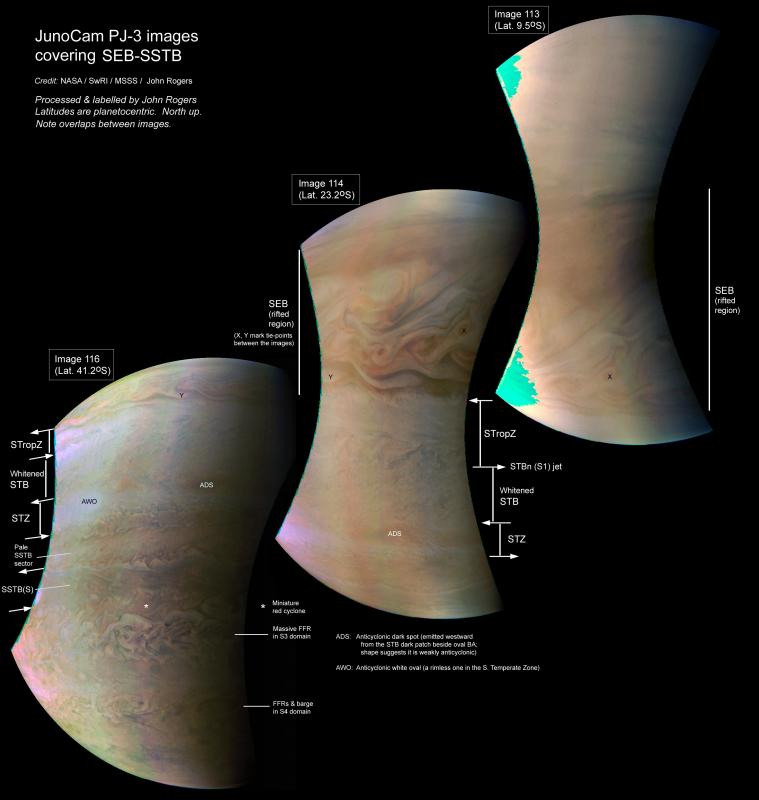
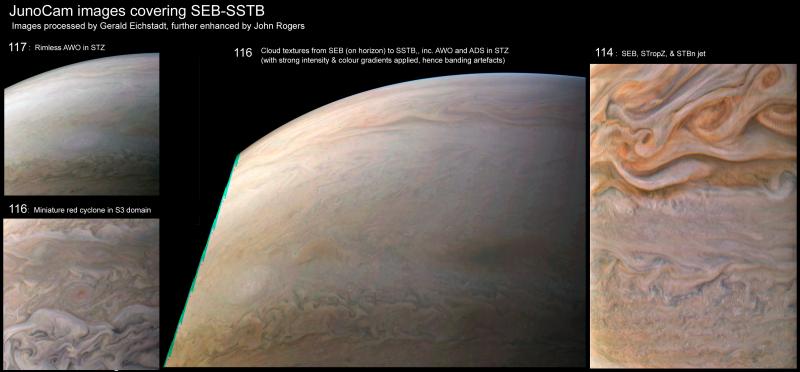
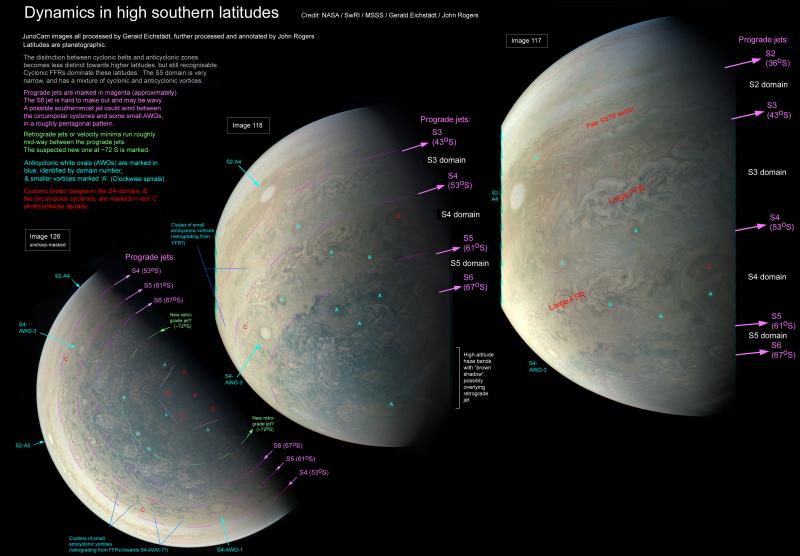
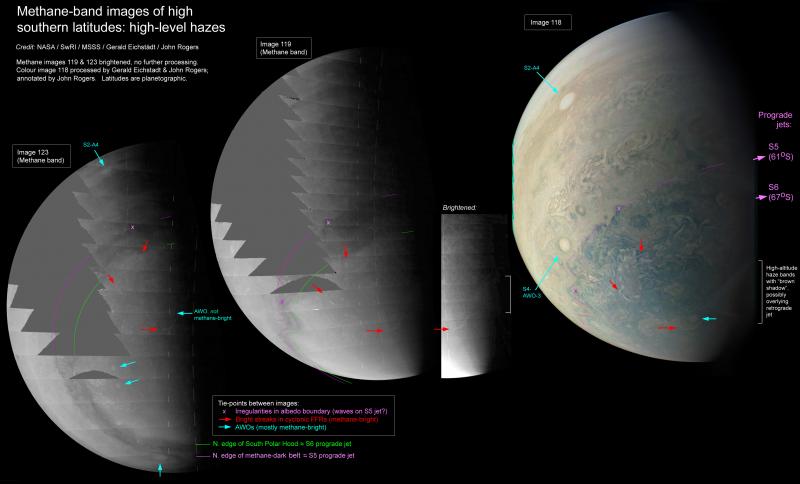
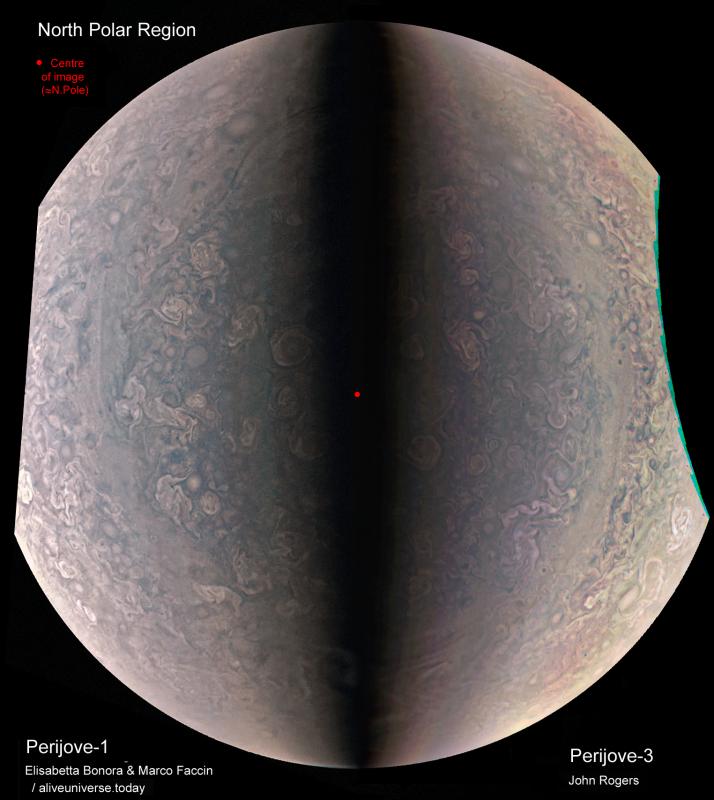
| The British Astronomical Association supports amateur astronomers around the UK and the rest of the world. Find out more about the BAA or join us. |
